While clothing is a consumer staple and, to some extent, insulated from the ups and downs of business cycles, the firms that get it right can see their share price skyrocket. The clothing market is very competitive, but good management and intelligent buying pays off.
YOUR CAPITAL IS AT RISK
Some of the branded stocks on our list may look fairly middle of the road in fashion terms, but their stock price performance is anything but. If the stars align, even dowdy retailers can see their stock price increase by more than 150% in less than a year.
This guide looks behind the curtain on six of the best clothing stocks to buy right now and offers inside tips on how to find the right broker to trade them.
Table of contents
- Is It a Fashionable Time to Be Investing in Clothing and Apparel Stocks?
- How Healthy Is the Clothing and Apparel Industry?
- The Best Clothing Stocks to Buy Right Now
- TJX Companies
- Lululemon Athletica
- Farfetch
- Ross Stores
- Tapestry, Inc.
- What to Know Before Investing in Clothing Stocks
- How to Start Trading Stocks Online
- Summary
Is It a Fashionable Time to Be Investing in Clothing and Apparel Stocks?
It can be said that fashion is always fashionable, but the companies and creators of sellable goods that pique the public’s interest can come and go like the wind. When you think of clothing, you think of basic necessities. Who doesn’t need clothing? This industry, however, can be very fickle. The latest trendsetter may rise and then fall as the next competitor comes along. On the whole, the industry could very well be performing admirably, but individual firms may not show success.
Some years back, prognosticators such as McKinsey and other industry observers predicted that the overall industry would grow at roughly 5% a year from 2018 forward. And then COVID-19 struck. The severe shaking of consumer behaviour benefited some firms and was detrimental to others, depending primarily upon what sector of the business the firm was in. Low-cost apparel did well. Sports apparel did not, but analysts are confident that consumer demand will shift.
Manufacturing costs have also forced major changes upon the industry in the past few decades, but the digital age is now upon us. Companies must use technology to compete effectively in today’s market by bringing their ideas to consumers more quickly. Labour issues and global concerns over environmental sustainability add to the pressures that this industry must endure and address.

YOUR CAPITAL IS AT RISK
Investing in the clothing industry can be risky. It is highly competitive, and the pace of change is only increasing with each passing year. What are the major threats that could impact the clothing and apparel industry going forward? Here are just a few to consider:
- Consumer Sentiment: Generation X is now giving way to the Millennials. Attitudes and fashion consciousness are shifting, and retailers must adapt quickly when sustainability and social responsibility come into play.
- Environmental Impact: Unfortunately, there is a great deal of waste in the fashion industry, as well as a heavy dependence on water for production and securing raw materials. Technology will play a large role going forward.
- Labour Issues: Globalisation has enabled a dependence upon cheap labour, and studies reflect that extreme climate variations may put pressure on existing labour pools.
- Transportation Logistics: When oil resources are under pressure, all of this industry suffers, due in part to transportation woes and logistical timetables. Apparel and clothing stocks are not immune to these issues.
- Government Regulation: Concerns over water use, oil dependency and the environment could also drive government officials to be more aggressive in restrictive regulations.
How Healthy Is the Clothing and Apparel Industry?
How can we measure the health of the clothing and apparel industry? There may be private funds or thematic attempts to formulate a comparable index, but for now, most investors look to a sub-index of the S&P 500 index. Let’s take a look at the current charting for this sub-index:

YOUR CAPITAL IS AT RISK
A COVID-19-driven dip occurred in early 2020, but the industry has rebounded as a recovery in shopping by consumers took place in 2021. Apparel and clothing stocks, however, were not immune to the overall downturn in share prices that overwhelmed stock markets across the globe in 2022. The latter half of 2022 was a different story. Shopping picked up, and those store chains that found themselves well positioned for a recovery were the first to benefit.
What about 2023? McKinsey’s best thoughts on the topic are that the industry will not deliver the same level of profit growth in 2020-2021, some 21% overall, and that going forward, growth rates might be sluggish, except in the luxury sector. There will be challenges, but there will always be companies that are ahead of the game and adapt to increasing complexity. The best clothing stocks detailed below could be the firms that will shine.
The Best Clothing Stocks to Buy Right Now
The clothing and apparel sector reflects the fashion tastes of individual consumers, so the nature of these companies is also particularly diverse. As a result, our top six clothing stocks offer exposure to firms that are very different from each other and operating in different parts of the world.
It’s not a question of high fashion or low fashion, more a case of spotting the business with a good business model, an eye for current trends, and a share price positioned to head higher.
TJX Companies
TJX Companies, based out of Massachusetts, contains a range of household names that operate from North America to Europe and Australia. Brands include Marshalls, TJ Maxx, TK Maxx, Sierra, and Winners.
The investment opportunity relating to TJX relates to its approach to doing business. The firm scoops up excess or unwanted stock that strong-brand retailers no longer want. The COVID-19 pandemic, therefore, represented something of a golden opportunity for the firm.
With their stores boarded up due to lockdown, retailers such as GAP cancelled or refused shipments from producers in Asia. TJX stepped in and bought up inventory at the bottom of the market. As CEO Ernie Herrman explains: “Historically, disruptions in the marketplace have created off-price buying opportunities for us.” (S&P Global)
After its recent third fiscal quarter, the company announced a $0.295 dividend for shareholders of record on 1st December. Based on these results alone, analysts at Barclays raised their price target from $76 to $94.
The number of hedge funds following this stock has also increased by 10%. Fund managers have noted that TJX benefited handsomely from the COVID-19 pandemic and was able to capture the change in consumers’ attitudes. Eager shoppers in both the US and Europe were quick to visit TJX for the bargains that it is known for.
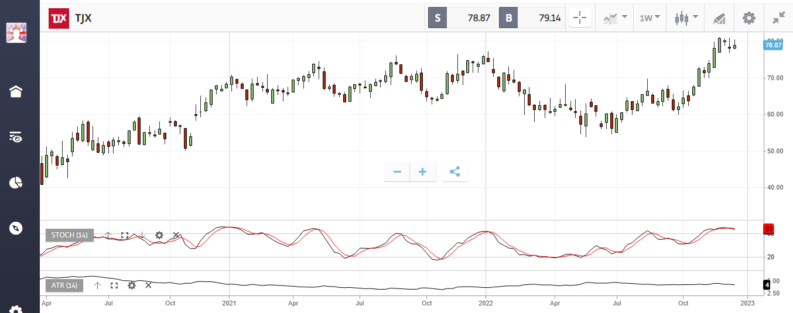
YOUR CAPITAL IS AT RISK
The TJX stock price is currently $78.87 at the time of writing. It has more than doubled from its 2020 lows, and shows no signs of slowing down, having already recovered from its mid-year dip in 2022. If analysts are correct, a $94 price looks doable.
Lululemon Athletica
Another clothing retailer that is a good prospect is athleisure wear specialist Lululemon Athletica. The firm was already building a clothing market share prior to the global lockdown, but its range of comfortable but classy products was the perfect fit for home-based working. The firm uses a two-pronged attack in the Canadian market by selling directly to consumers, as well as through its company-owned outlets.
The firm has pioneered the home-shopping revolution and provides a live chat service for clients looking to learn more about an online product. It has also adopted Klarna to make payment easier and has got a good track record of complying with ethical concerns such as modern slavery and gender pay gaps.
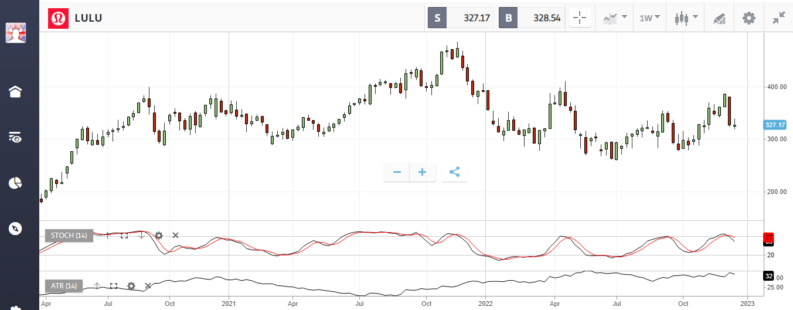
The firm’s stock has been on a tear since pre-pandemic, nearly tripling in value. It has pulled back to catch its breath, now sitting at $327, roughly support from late 2020. JP Morgan analysts, however, have a price target of $413, having recently reduced it from $464.
Farfetch
Farfetch, headquartered in London, may be a good play if the analysts are correct about luxury goods outperforming the general apparel and clothing market. The firm’s specialty is selling luxury goods online to the US, Europe, and other global marketplaces. Share prices hit a high of nearly $75 in early 2021, but have nosedived down to $4.45.
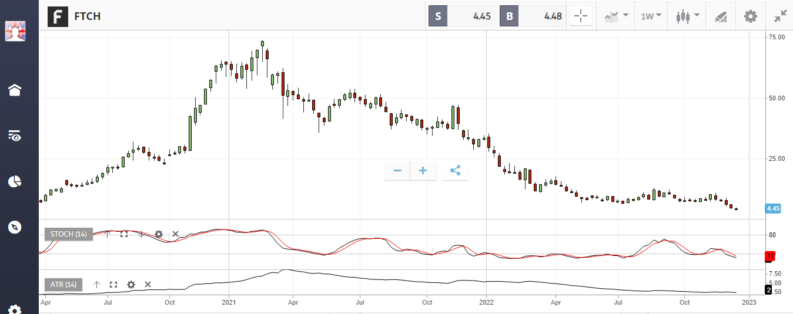
YOUR CAPITAL IS AT RISK
At these low prices, hedge funds have piled in, raising the number of funds owning FTCH from 39 to 50 firms. Societe Generale has also reiterated its ‘Buy’ recommendation and revised its target upward to $12. Analysts regard Farfetch as the premier luxury online marketplace, far surpassing its competitors in reach and diversity of products offered. Do you hear ‘undervalued’?
NIKE
NIKE, a perennial favourite among investors, hit a stock price high of $175+ at the end of 2021, only to fall sharply in 2022 down to $112. NIKE is the obvious leader in its field of athletic footwear, apparel and equipment, but it is one firm that has suffered due to high shipping costs and the ongoing strength of the US dollar.
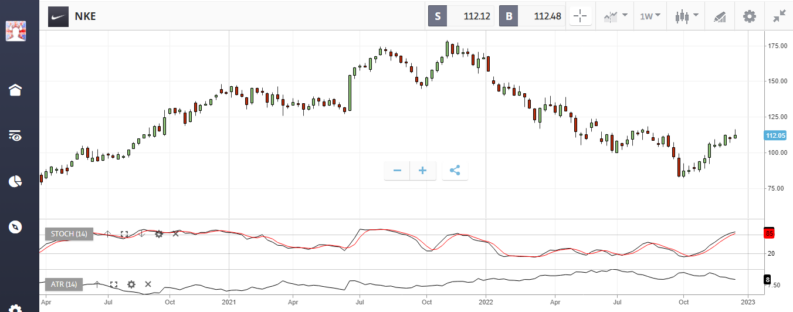
Share prices have recovered a bit of late, but analysts regard NIKE as a good long-term investment, and expect it to regain its form and deliver 10% revenue growth and accelerating profit margins. The global demand for active wear is a trend favouring NIKE, and quality usually does rise to the top.
Ross Stores
Ross Stores is yet another off-price apparel and home fashion retailer. Headquartered in California, the company has survived a round of store closures made during the pandemic, only to see demand increase for its products. As a result, its profits have gyrated, the reason for the rollercoaster appearance of its share-pricing chart.
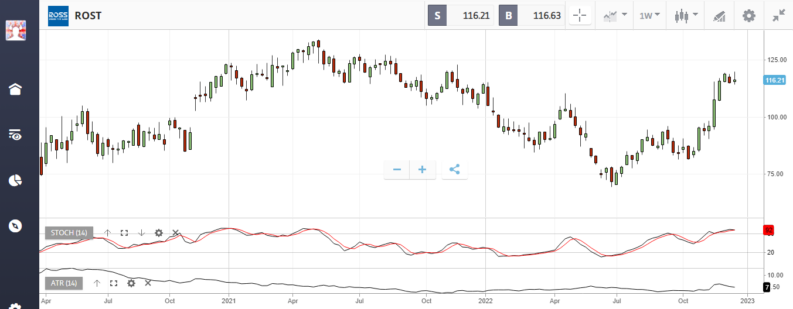
Results for Q3 2022 beat Street estimates, and prices rose accordingly. Analysts at Barclays have restated their ‘Overweight’ rating and are targeting $127. Current share price is $116.
Tapestry, Inc.
Tapestry represents another play in the luxury segment of accessories and lifestyle products. The firm focuses on markets in the US, China, Japan, and other selected international markets.
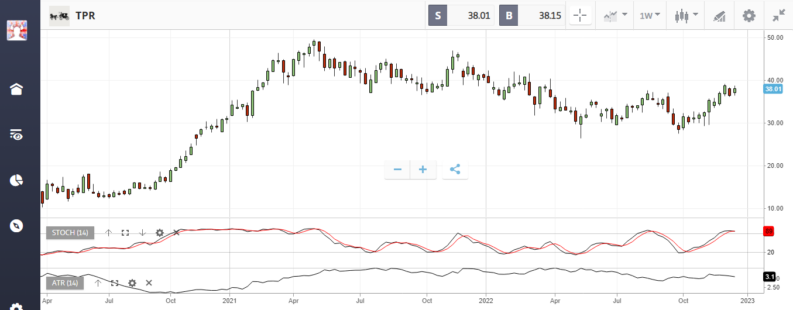
YOUR CAPITAL IS AT RISK
The stock soared in late 2021, tripling in value in six months, but it has tapered off slowly to $38 today. Analysts at Citibank are targeting $42, but it set a high of $50 in May 2021. Do you want to bet?
What to Know Before Investing in Clothing Stocks
It’s important to keep a few factors in mind when trading retail company stocks:
- Firms do go bust – This highly competitive sector has claimed many high-profile victims, and if this happens, equity holders see their positions go to zero.
- Reputational risk – The clothing industry has the second-largest carbon footprint in the world. Fast fashion risks losing its client base if ethical concerns outweigh the ‘must-have’ attraction of items.
- Squeezed margins – Labour practices in the industry have come under intense scrutiny. Operators are now looking a long way down their supply chain to ensure that workers are paid a fair wage, and unless these added costs are passed on to consumers, profits will decrease.
- High Street challenges — Even before the pandemic, the High Street was on its knees. How this situation pans out will be crucial to the fortunes of clothing retailers and the price of their stock.
How to Start Trading Stocks Online
Stock trading has been transformed by online platforms and mobile trading apps. Accounts take minutes to set up and brokers offer free demo accounts to practice with and an extensive range of research and analysis tools to help you develop your trading skills.
The ‘democratisation’ of trading has also seen costs driven down as brokers compete for market share.
It’s particularly important for beginners to appreciate the need to use a well-regulated broker – one operating under licence from any of the below is a good place to start.
Tier-1 Regulators
- Financial Conduct Authority (FCA)
- Australian Securities and Investments Commission (ASIC)
- US Securities and Exchange Commission (SEC)
- Cyprus Securities and Exchange Commission (CySEC)
1. Research Clothing Stocks
Successful trading relies on basing decisions on a well-thought-out strategy. Brokers offer free in-depth analysis and news feeds on the different stocks, and taking advantage of that offer is a good first step.
2. Find a Broker
Different brokers specialise in different markets. If you’re looking to trade a particular name, it’s worth checking if your broker of choice covers that market prior to going through the registration process.
Broker choice will to a large extent come down to personal preference. Each broker has a different ‘feel’, and finding one to suit you is important. It might be the case that you’re looking to trade on the go, in which case cross-referencing to these reviews will help you find out those ranked highly in terms of mobile trading.
3. Open and Fund an Account
Brokers are required to ask a few questions of onboarding clients. These are to comply with regulatory obligations and designed to protect the customer. While they involve a bit of form filling, they are ultimately a sign that you’re making a good broker choice.
Funding accounts is very straightforward, but costs and speed of processing may be factors you want to consider. Trading is hard enough without paying out on account admin charges, so it is worth checking the T&Cs of your short-listed brokers.
The process of verifying your account and logging your Know Your Client (KYC) documentation should take only a matter of minutes. After that, you’re ready to fund your account and start trading
4. Set Order Types
Practicing using a demo account is a good way to get to grips with the mechanics of trading. Demo accounts use virtual funds, so fat-finger errors won’t cost you but will instead represent valuable lessons on how to trade.
The platforms will offer you a range of order types that can help you manage risk. Stop losses are trading instructions that are built into your account to kick you out of a position at a certain price. This is very useful in the event that a position goes wrong.
Take-profit instructions are automated instructions that work in the opposite direction.
5. Select and Buy Clothing Stocks
Buying the best clothing stocks is as simple as logging on, entering the amount of shares you want to purchase, and clicking ‘buy’.
eToro: 68% of retail CFD accounts lose money
Take a lookTickmill: FCA Regulated
Take a lookIG: Over 16k stocks to trade
Take a lookThese trading platforms have invested heavily in developing functionality, which is ideal for beginners. They’ve also addressed the issue of client safety and operate under licence from Tier-1 regulators. Successful trading involves choosing a safe broker that offers extra support, such as educational resources and high-quality customer service. These brokers tick those boxes, and even if you’re just curious, it’s possible to visit their sites and try the service in a risk-free demo account.
Summary
Hunting out the best clothing stocks can be a profitable experience. There are risks involved with all trading, but by choosing a safe broker, you at least mitigate the risk of losing your money to a scammer.
Investing in clothing retailers also offers investors the chance to carry out ground-level research. Institutional investors send interns and analysts out to stores to ‘see if they’re busy’, and in the same way, there’s nothing to stop individual investors going with their gut instinct on how they think a particular brand might fare.













